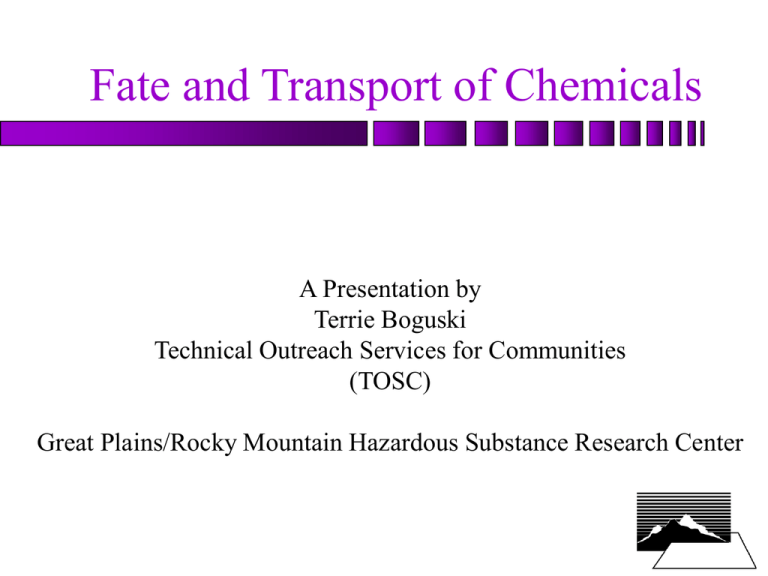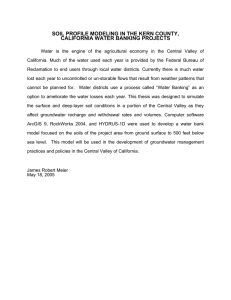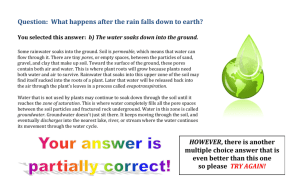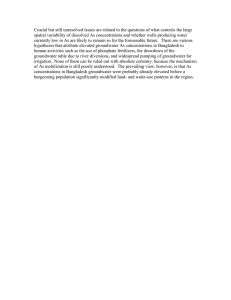Fate and Transport of Chemicals
advertisement

Fate and Transport of Chemicals A Presentation by Terrie Boguski Technical Outreach Services for Communities (TOSC) Great Plains/Rocky Mountain Hazardous Substance Research Center What Happens when Chemicals Spill? volatilize into the air stick to the soil run off into streams or lakes percolate down through the soil – float on the water table – sink under the aquifer – dissolve in the groundwater destroyed by bacteria Volatilization When chemicals volatilize into the air the concentrations may become dilute enough to cause no harm. Risk depends on the concentration of exposure and the type of chemical Volatilization When chemicals in soil volatilize into the air people in nearby structures may be affected by increasing concentrations Soil Contamination When toxic chemicals remain in the soil contact with the soil may be harmful to people Runoff Chemicals that run off into streams, lakes or the ocean may harm wildlife or contaminate drinking water Groundwater Contamination Chemicals may move through the soil and dissolve in groundwater People using groundwater for drinking may be at risk Unsaturated zone Contaminants Shallow Aquifer Groundwater flow Aquitard (Clay layer) Confined Aquifer What Determines How Chemicals Move? Nature of the chemical – some chemicals react with soil material and precipitate (become solid) – some react and become more mobile – some are more easily degraded in the environment – some dissolve in water Hydrologic cycle – climate and the water cycle influence how chemicals are carried through the environment » precipitation » depth to groundwater » rate of groundwater flow What Determines How Chemicals Move? Geology – layers and areas of higher and lower permeability » clay and unfractured rock are less permeable » gravel and sand are more permeable Amount of organic material in the soil – certain chemicals tend to stick to organic material and don’t move so quickly or so far Trichloroethylene (TCE) high volatility— volatilizes easily in air – remediation sometimes consists of bubbling air through TCE contaminated water » in-well vapor extraction » pump and treat with air stripping low solubility— dissolves slowly in water – free product tends to pool in the subsurface and then slowly dissolve into groundwater – may provide a continuous source of contamination over a long time period TCE biodegrades anaerobically – bacteria that live without oxygen can break down TCE while living on other nutrients in the soil – breaks down into cis-DCE or trans-DCE, then into vinyl chloride (VC) in a very slow step-wise fashion when conditions are right – sometimes see build up of VC at older sites TCE cis-DCE VC ethylene (?) rate limiting step Risk only Exists if... 3. There is a pathway for exposure 1.Contaminants exist 4. There are 2.Concentrations are receptors high enough (people, animals sensitive ecosystem Exposure Pathways Inhalation Ingestion of soil and groundwater Absorption through skin How to exclude pathways Institutional Controls – restrict land use, prohibit drinking water wells Engineered Barriers – parking lots, clean soil cover, clay or man-made caps, barrier walls Control Activities – groundwater pumping » to prevent groundwater from contacting contaminated soil or to prevent migration of groundwater Risk Management Goal – Reduce concentrations at point of exposure to acceptable levels by... – Source removal » removing contaminated soil from the site – Treatment and containment » treating and containing soil in monitored landfill – Elimination of exposure pathways » engineering and/or institutional controls




